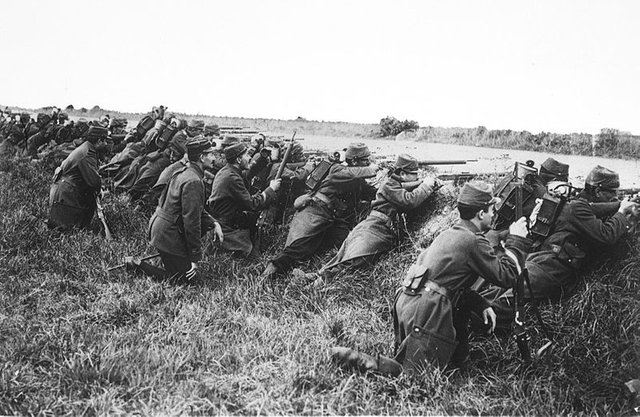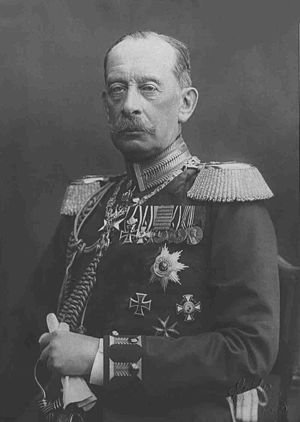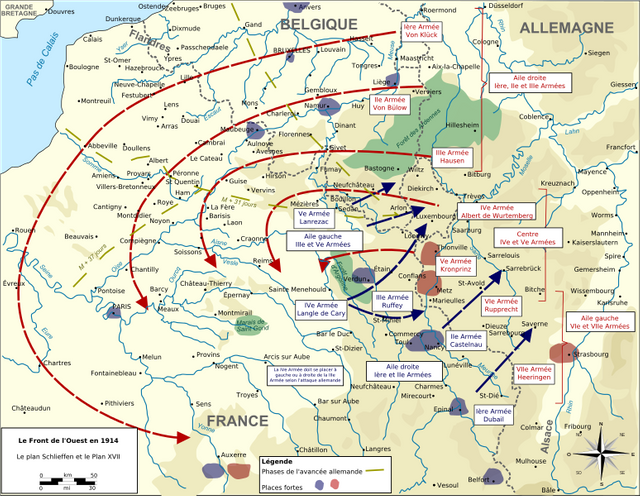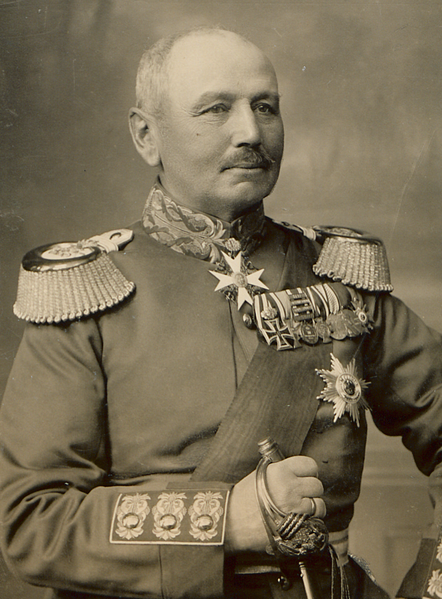The Great War Centenary: Part Three, Invasion
Austria-Hungary had declared war on Serbia in July 1914. Both Germany and Russia had joined on either side. When and how did the first major military conflicts begin, and were they prepared for it?
This is Part Three of a series of posts leading up to the centenary of the end of The Great War on November 11, 2018. For the events leading up to Hungary-Austria's declaration of war on Serbia, please see The Great War Centenary: Part Two, The Spark

French infantry charge, 1914
The Schlieffen Plan
The Germans had been expecting war for a long time. German forces had defeated France in the 1870 Franco-Prussian War, leaving the French in disarray and bitter over the annexing of Alsace-Lorraine. Assuming that their bitter enemy France would soon attack them to reclaim Alsace-Lorraine, a plan was drawn up by Moltke (the Elder) immediately after the war. He knew that it was only superior training that had allowed the Prussians to beat the French and thought another rapid victory was unlikely against the powerful French army. He also assumed that any future war would involve both France and its Russian ally. He considered that the war would have to be short, sharp and incomplete.

Count Alfred von Schlieffen
In 1891 Count Alfred von Schlieffen was appointed Chief of the Imperial Army German General Staff. He updated and revised Moltke's plan. The updated plan would take into account the many new factors that had arisen after 1870, including:
- Germany's diplomatic isolation, only having one dependable ally in Austria-Hungary, which left the problem of a two-front war since France and Russia were such staunch allies
- New technologies: weapons such as machine guns and modern artillery, new forms of communications like the telephone and radio
- The size of the European armies had skyrocketed and the Germans were out-numbered 5:3 and so a war of attrition would not be winnable
It was an offensive plan to avoid a war of attrition and of course to never take a defensive posture against the arch-enemy France. It turned out to be the most ambitious military plan in history.
In 1905 Schlieffen revised the plan to cater for what he thought was an overestimation of Russia's strength having lost the Russo-Japanese War (1904 - 1905). His plan then focused on a war against France. He wrote that the trigger for the war would be when Russia began mobilising its forces, which he calculated would take six weeks.

The plan was to mass a German army near the western Franco-German border, in Alsace-Lorraine. The idea was to lure France to attack them and reclaim its territory. However, the German forces were to fall back and let the French press deeper into Germany.
Meanwhile, the main German army would invade France on the right flank, through Belgium. This was an acknowledgement that violating Belgium's neutrality could bring Britain into the war.
The Germans would have six weeks to defeat France, wheeling their army toward the undefended right flank near the English Channel, encircling Paris and finally defeating the French troops returning from the western front. This would require great speed and incredibly detailed plans were made for trains to rapidly transport the troops south. One army corps alone – out of a total of 40 in the German forces – required 170 railway cars for the officers, 965 for infantry, 2,960 for cavalry, 1,915 for artillery and supply wagons. From the moment the order was given everything was to move at fixed times according to a schedule precise down to the number of train axles that would pass over a given bridge at a given time.
Once the French were defeated they would load all the troops onto trains and rapidly move them to the Eastern front to face the Russians. They would not fall into Napoleon's trap and be lured into the vast nothingness of the Russian plains but would take on and defeat the weakened Russians on the Bavarian border. That was basically the extent of the Russian plan.
This was the plan, the so-called blueprint to victory, that Schlieffen's successor, General Helmuth Moltke (the Younger), put into effect. The plan was inflexible and had no alternative. It had to be executed exactly to plan. Any mistakes or delays would cause the plan to crumble. Even the train schedule didn't account for delays or broken tracks.
Into battle
On the morning of 4 August 1914, Germany invaded neutral Belgium. Their first priority was to secure Liège – a vital railway hub. The Battle of Liège was the first engagement in the German invasion of Belgium and the first battle of World War I. They unleashed their fearsome new weaponry on the Belgian defenders causing terrible carnage. Yet a battle that had been scheduled to last two days took almost two weeks to end. As the Belgians – and later the French – retreated, they blew up bridges and railway lines, which the Germans had to rebuild. This caused further delay.
The Germans were counting on getting through Belgium and capturing Paris before the British could react. However, with all the holdups, the Germans were met by the British Expeditionary Force (BEF) at Mons, Belgium on 23 August 1914.

BEF Riflemen at the Battle of Mons, August 23rd, 1914
Mons is located near the English Channel coast where the Schlieffen Plan placed the German 1st Army, led by General Alexander von Kluck, to sweep its way down and encircle the French army.
On that day von Kluck was given orders to cross the Mons canal and occupy the ground to the south of it and force the enemy eastwards cutting off their retreat to the west. The Battle of Mons was underway with the British under heavy bombardment, but they inflicted severe casualties on the Germans. The Germans marched in formation making easy targets for the British who mowed them down.
The German attack had been a costly failure. But they regrouped in open formation and expanded their attack on the British, who were forced to retreat. The BEF later formed a defensive line and once again came under heavy German bombardment and also discovered that the French army had retreated, leaving them exposed. General French, leader of the BEF had wanted his forces to withdraw to the coast but Lord Kitchener overruled this ordering that the BEF should not separate itself from the French army.
As the Germans approached Paris, the citizens were preparing for a siege. They were ready to take down all the bridges and had closed all the sewers. They were even going to blow up the Eiffel Tower.
The German advance got them as near as 50 km to Paris. General von Moltke changed the order of battle for the German attack and ordered that Paris would now be bypassed and the sweep intended to encircle the city would now seek to entrap the French forces between Paris and Verdun. Von Kluck’s 1st Army would protect the flank of the main striking force. In effect, this snatched glory away from von Kluck whose force would have struck the decisive blow according to the original plan.

General Alexander von Kluck
Unable to take the humiliation, von Kluck disobeyed the order and continued pursuing the retreating British forces. He pushed his men hard, stretching his supply lines and exhausting his men. And more importantly, it opened up a gap between his army and the closest German reinforcements.
Allied air reconnaissance discovered the gap. The exhausted French army under the command of Joseph Joffre had been on the retreat for nearly two weeks when they reached an area to the south of the River Marne. They had to stop and face the Germans once again.
On September 6th the Allies counterattacked, exploiting the break in the German lines, sending the BEF and the French Fifth Army into the gap between the two German armies. The Battle of the Marne was underway.
The French army managed to increase the gap between the German First and Second Armies. This further hampered communications for the Germans. This meant that the senior officers commanding the German attack got confusing messages about what was going on in the actual battle zone.
Von Moltke feared that the Allies were in a position to halt the German advance and defeat the German armies involved in the attack on Paris. Because of this communication breakdown, on September 9th, von Moltke ordered his armies to retreat and they withdrew to an area near the River Aisne. Here the Germans dug in and dug trenches.
Trench warfare had started and would dominate the war for several years to come.
The aftermath
Some 250,000 French soldiers were killed in the Battle of the Marne. The Germans suffered about the same casualties. The BEF lost just under 13,000 men. However, Paris was saved and the Germans never entered it during the war.
The Schlieffen Plan had failed. The Germans were now fighting a war on two fronts. The Schlieffen Plan was a plan of attack and did not cater for either defeat or retreat. So the German troops weren't trained in defensive warfare, and certainly not in trench warfare. The German army, with no plan in retreat, dug in and waited in their trenches for the advancing Allied army.
In effect, the Germans had lost the war in the first month of its existence. It was now a war of attrition - something the Schlieffen Plan had said could not be won.
This series on World War One will be continued in Part Four, tomorrow
Previous post in this series:
The Great War Centenary: Introduction.
The Great War Centenary: Part One, The Tinderbox
The Great War Centenary: Part Two, The Spark
References:
The Guns of August, Barbara Tuchman
https://en.wikipedia.org/wiki/German_invasion_of_Belgium
https://en.wikipedia.org/wiki/Schlieffen_Plan
https://www.historylearningsite.co.uk/world-war-one/battles-of-world-war-one/the-first-battle-of-the-marne/
https://www.britannica.com/event/First-Battle-of-the-Marne
https://en.wikipedia.org/wiki/First_Battle_of_the_Marne
Excellent summary of an incredibly complex series of events. Amazing how ego got in the way of an already failing plan - one that was arguably failing also because of the ego of the original planner, Schlieffen.
Thanks, @kiligirl! The Germans have always had a thing about the trains running on time, haven't they?
Ai yi yi....
Thank you for a comprehensive summary, and including your map, made it the events much clearer. I enjoy this series.
Thanks @johannvdwalt
I had no idea the war was already defined in the first month! Curious.
It is the great tragedy that the war had to drag on for more than four years in a stalemate position, with little hope of Germany winning. From then on it sucked up lives at a rate of 5,000 and sometimes 50,000 a day